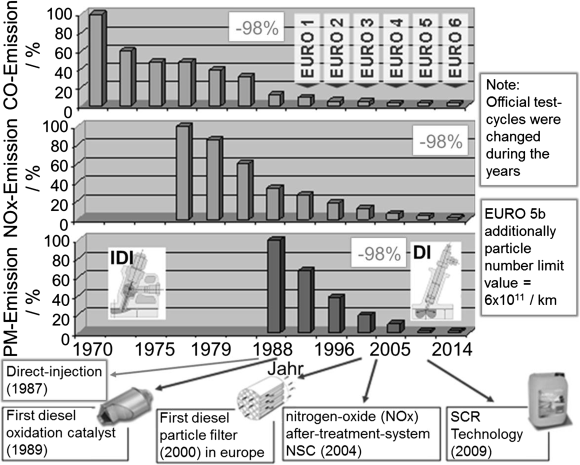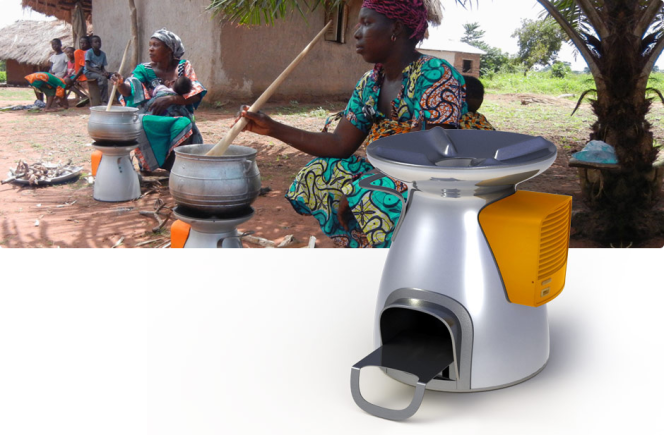Regardless of net climate forcing or other climatic effects, all black carbon mitigation options bring health benefits through reduced particulate matter exposure
‘The best estimate of industrial-era climate forcing of black carbon through all forcing mechanisms, including clouds and cryosphere forcing, is +1.1 W/m 2 with 90% uncertainty bounds of +0.17 to +2.1 W/m 2. Thus, there is a very high probability that black carbon emissions, independent of co-emitted species, have a positive forcing and warm the climate. We estimate that black carbon, with a total climate forcing of +1.1 W/m 2, is the second most important human emission in terms of its climate forcing in the present-day atmosphere; only carbon dioxide is estimated to have a greater forcing…’ Bond, T. C. et al, 2013, Bounding the role of black carbon in the climate system: A scientific assessment, JOURNAL OF GEOPHYSICAL RESEARCH: ATMOSPHERES, VOL. 118, 5380–5552, doi:10.1002/jgrd.50171
Figure 1: Schematic of black carbon source and processes (Bond et al, 2013)
The net effect of black carbon in the atmosphere depends on cloud effects and co-emitted gases and aerosols. Climate forcing from diesel engines, brick kilns and residential solid fuel stoves are net positive – shown in the red bars below. Burning of fields and forest forcings do not include CO2 emissions from land use changes or loss of soil organic carbon.
Figure 2: Net forcing from BC sources (Source: Bond et al 2013)
Black carbon emissions increase with industrialisation and then fall off rapidly. This can be seen in the relative size of regional emissions.
Figure 3: Emission rates of BC in the year 2000 by region, indicating major source categories in each region (Source: Bond et al 2013)
Mitigation with existing technology is well underway.
Diesel Engines
‘On-road diesel engines include diesel cars and trucks, while off-road engines include engines used in agriculture, construction, and other heavy equipment. The diesel-engine category in this assessment specifically excludes shipping emissions, which are summarized separately. Diesel engines contributed about 20% of global BC emissions in 2000. These sources have the lowest co-emissions of aerosols or aerosol precursors of all the major BC sources. In order to enable use of the most advanced exhaust controls, sulfur must be removed from the diesel fuel during refining. Therefore, in regions with fewer controls, primary particulate matter emission factors are higher, but SO2 emissions are also higher….
Diesel engine sources of BC appear to offer the best mitigation potential to reduce near-term climate forcing. In developed countries, retrofitting older diesel vehicles and engines is a key mitigation strategy; in developing countries, transitioning a growing vehicle fleet to a cleaner fleet will be important.’ Bond et al 2013
Figure 4: Improvements in diesel engine emissions – http://www.occup-med.com/content/9/1/6
Essentially this appears to be business as usual. Replacement of older equipment with newer and more efficient equipment.
Industrial Coal
‘Industrial coal combustion is estimated to provide about 9% of global emissions, mainly in small boilers, process heat for brick and lime kilns, and coke production for the steel industry. Although coal combustors can be designed to produce little BC, coal can also be highly polluting when burned in simple combustors, which are still present in small industries, particularly in developing countries. Co-emitted SO2 is estimated from coal sulfur content and exhaust control. The SO2/BC ratio for industrial coal is much higher than that for the other emission categories, where the fuel has little sulfur or more efficient flue-gas controls are in place. Emissions from coal-fired power plants, which emit much less BC because of their better combustion efficiency, are not included here.’ Bond et al 2013
Residential Solid Fuels
‘Wood, agricultural waste, dung, and coal are used for cooking or heating in homes, providing another 25% of BC emissions. Most of the emissions occur in single-family devices, which are often of simple design. When infrastructure and income do not allow access to low-emission residential energy sources such as electricity and natural gas, solid fuels are used extensively for cooking. Otherwise, they are used more often for heating. Coal and, less frequently, wood are also used for heating in multi-family building boilers. The designation “cooking” in Figure 2 refers to regions where wood is primarily used for cooking, even if some heating occurs. Similarly, “heating” includes all uses in regions where heating is dominant. This sector also includes emissions from both production and consumption of charcoal. The poor combustion and mixing in these simple devices result in relatively high POA:BC ratios, but SO2 emissions are low except for coal.’ Bond et al 2013
Figure 5: Biolite home stove
http://www.biolitestove.com/homestove/
50% Less Wood Consumed Time and Cash Savings
95% Smoke Reduction Improved Health
Nearly Eliminates Black Carbon Protects Climate
Generates Electricity Charges Phones & LED Lights
As well as prevention of millions of premature deaths.
Open Burning
‘Open burning of biomass in the location where it is grown is a very large contributor to global BC emissions, with bottom-up estimates predicting that it contributes about 40% of the total… Current global emissions estimated from open burning range between 2000 and 11,000 Gg/yr for BC and between 18,000 and 77,000 Gg/yr for OC in average years… Most studies fall into the range of 2000 to 6000 Gg/yr for BC and 20,000 to 27,000 Gg/yr for OC… A smaller contribution originates from open burning in agricultural fields, which is often done to clear residues after harvest. This source contributes about 300 Gg/yr BC and 1500 Gg/yr OC. In regions like south Asia, this source can contribute about 20% of carbonaceous aerosol emissions.’ Bond et al 2013
Crop residue is far better preserved in soil carbon than burnt – http://watertechbyrie.com/2014/06/26/food-for-people-conserving-and-restoring-soils/
Some forest types are adapted to burning – but if it results in land use change the carbon impacts are a significant factor in climate change.
Figure 6: Carbon dioxide emissions by source
When black carbon is factored in – carbon dioxide from fossil fuels is the smaller part of the problem. Reduction in black carbon emissions are feasible with existing technology – relatively inexpensively and with the potential the potential to save lives.







Interesting post. I especially enjoyed the climate forcing and co-emitted species graphics. I was surprised that estimated biofuel cooking emissions greatly exceed industrial coal emissions.
I have been looking around the globe frequently over the last year using NASA’s Worldview web page tools including AOD and fire locations and from a global perspective subjectively to me it seems like biomass burning could easily be the dominant source of carbon in the atmosphere. My guess would be on the order of 60 to 70 percent of total carbon over the last year. Much of the burning is from human agricultural related activities, but also from numerous large wildfires in dry areas sometimes aggravated by human activities. There have been quite a few large forest fire smoke plumes in the southern US in recent days. I remember seeing huge amounts of smoke for weeks last summer coming from northwestern Canada and lesser amounts from forest fires in mountainous areas of the western US. In recent weeks there has been a lot of smoke coming from the southern portions of western Africa. And of course there is always lots of smoke around India and China, although there it is more difficult to determine how much is from non-biomass burning and perhaps the majority there is non-biomass and probably includes a lot of coal and biofuel cooking emissions.
We are rapidly approaching the agricultural burning smoke season in Mexico and Central America that every April-May sends substantial smoke to my homeland here in Central Texas. Biomass smoke is a BIG challenge for modeling and forecasting fine particulate matter concentrations, not to mention attribution of sources.
It seems to me there are regions, such as Latin America, where black carbon emissions can be reduced quite easily. This can be accomplished by implementing emissions inspections for diesel power vehicles and reducing fuel subsidies such as are used in countries like Venezuela (where diesel fuel is practically given away and used in buses and trucks which spew black clouds of smoke almost all the time).
Rob Ellison
There was an interesting observation with regards to tuberculosis in the USA during the early part of the 20th Century. By 1930, the incidence of TB began to decline followed by the prevalence a decade later. There were no breakthroughs regarding TB medications or procedures. Streptomycin as a treatment wasn’t identified until the late 1940’s and INH became available even later.
What had happened, the rapid residential conversion of home heating from coal to natural gas. The gas piping had previously been installed for gas lighting. With mass electrification of homes by 1920’s, gas conversion units replaced the coal grates in the existing gravity heating furnaces.
As a dramatic by-product of the residential conversion from coal to gas, the respiratory particulate burden plummeted. This was documented by autopsy lung specimens in police officers walking the beat in cities like Cleveland, Chicago, Detroit, Buffalo, Pittsburg, etc. From the turn of the 19th Century to the late 1920’s, most cop’s lungs had large carbon particle deposits. After 1930 or so, there was a dramatic fall off in the carbon deposits found in the lungs.
The decline in the incidence of TB, the rapid conversion of residential coal furnaces to burning natural gas, and the decline in particulate deposits in these lungs suggest that the respiratory burden of black carbon overwhelms the lung’s ability at airway clearance providing a permissive environment for opportunistic infections. The “cure” for TB on a large population basis was to reduce Black Carbon.
Wood stoves, open indoor burning appear to be another issue. Mainly, the combustion process, particularly pyrolysis under a starved oxygen environment, produces aldehydes which have a direct toxic effect on the respiratory mucociliary escalator, damage macrophages and epithelial cells. Again, providing a permissive environment for respiratory infections. The people burning charcoal and biomass to cook their daily meal, particularly indoors but also outdoors to a lesser extent, have more respiratory illnesses adding to the shortening of their lives.
Coal burning base load electricity plants can control their black carbon emissions. Cooking with biofuels needs another system altogether to control aldehydes, etc, preferably, electric cooking.